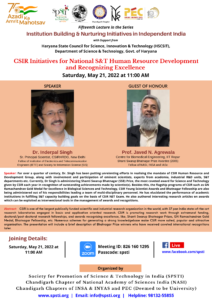CSIR (Council of Scientific and Industrial Research) Yeoman Service to the Country to raise Science and Industrial Research to World Level
CSIR is one of the largest publicly funded scientific and industrial research organizations in the world, with 37 pan India state-of-the-art research laboratories along with 39 outreach centres engaged in basic and application-oriented research. It promotes research work through extramural funding, doctoral/postdoctoral research fellowships, and awards recognizing excellence, like the Shanti Swarup Bhatnagar Prizes, G N Ramachandran Gold Medal, Bhatnagar Fellowship, etc. Numerous schemes for generating a strong knowledge base make CSIR a more suited, popular, and attractive organization. The audience at a webinar was being apprised of such facts in a lecture entitled “CSIR Initiatives for National S&T Human Resource Development and Recognising Excellence” delivered by Dr. Inderpal Singh, Sr. Principal Scientist, CSIR-HRDG, New Delhi. HRDG (Human Resource Development Group) is a division of CSIR which realises this objective through various grants, fellowship schemes etc.
The CSIR was established in the year 1942, when it provided extramural research support to scientists working in universities and R&D institutions in with ‘Research Schemes’. According to the SCImago Institutions ranking world report 2022, CSIR is ranked at 39th among 1,745 institutions worldwide. At present, the scientific staff of CSIR constitutes about 3-4% of India’s scientific manpower but they contribute to nearly 10% of India’s scientific output. According to Stanford University list of the world top 2% most widely cited scientists in twenty-two disciplines, 2,709 scientists are from India and CSIR contribute about 26% of these.
Prof. Arun K. Grover, Vice-President of SPSTI, in his opening address said that during the colonial rule, stalwarts among Indian scientists got many international recognitions. Soon after 1947, the Padma awards were instituted and once it got under way, it was realized that many of the awardees were scientists and University academics. So soon after the passing away of Dr. S. S. Bhatnagar, one of India’s foremost science administrators, the Bhatnagar awards were instituted, in 1956, for Indian Scientists, Engineers and Mathematicians working in India. Dr. Singh presented data on Bhatnagar Prize winners, who have received coveted national and international recognitions later, such as Fellow of Royal Academy (FRS). Also, most of them go on to become fellows of the Indian Science Academies. The Bhatnagar prize awardees over the years have also been awarded with various national recognitions like Padma Shri, Padma Bhushan, Padma Vibhushan, Bharat Ratna and many more. The number of women in all branches of the award is woefully low, but even then, the numbers show a rising trend. The latest list of The World Academy of Sciences (TWAS) prizes shows that there are 272 prize winners from 28 countries and India dominates with 65 recipients, followed by China. Of these 65, 51 are SS Bhatnagar prize awardees.
CSIR started conducting the NET exam in sciences, first held in 1983, taken by 5,577 students. Presently it takes place twice a year conducted by National Testing Authority (NTA) with around 2.25 lakhs students enrolling each time at 3,389 centres across the country.
CSIR young scientist award scheme was started to recognise the contribution made by young scientist with upper age limit of 35 years. It has been awarded to 213 scientists till date with women’s share of 14%. Over the years, the CSIR young scientist award gained importance as 20 of its recipients got prestigious S. S. Bhatnagar award.
The GNR Gold medal for excellence in biological sciences and technology was instituted in the memory of G. N. Ramachandran, maximum being awarded to scientists from Indian Institute of Science (8 out of 18) and has been only awarded to one women since its inception. Shanti Swaroop Bhatnagar Prize for science and technology till date has been awarded to 585 scientists. First and sole recipient in the 1958 was K S Krishnan. 2020 was iconic year as two scientists from each discipline, total 14 scientists were recommended for SSB prize. Most of these awards have gone to men and only 21 women could achieve the status of Bhatnagar awardee.
Talking about the international recognitions, he shared that there had been 49 scientists who had their tertiary level of education from India and were elected FRS, and of these, 25 are Bhatnagar awardees. K. S. Krishnan, the first recipient of the SS Bhatnagar prize, is the only scientist who has got the FRS, 18 years prior to the Bhatnagar award. National Academy of Sciences, USA has 2,400 members and 500 international members of which, 15 are from India, all of them being recipients of Bhatnagar prize except one. National Academy of Inventors (USA) has around 1,567 fellows and out of every 11 fellows one is Indian.
This was the fifteenth Lecture of the Web-series: Institution Building and Nurturing Initiatives in Independent India. The Society for Promotion of Science & Technology in India (SPSTI) organised the lecture in association with Chandigarh Chapter of the NASI and Chandigarh chapters of INSA & INYAS and Punjab Engineering College (PEC) (Deemed to be University), Chandigarh and with support from the Department of Science & Technology, Haryana. It was streamed live at 11.00 am on May 21, 2022 through Zoom and Facebook.
At the beginning of the program, Dr. Deepak Salunke, Panjab University, Chandigarh introduced the Guest of Honor, Prof. Javed N. Agrewala, Centre for Biomedical Engineering, IIT Ropar, a Shanti Swarup Bhatnagar Prize Awardee and Fellow of NASI, INSA and IASc to the audience. Prof Sanjeev Kumar, Dean Students Affairs, Punjab Engineering College introduced the speaker of the day.
Also present on the occasion were Shri Dharam Vir, President, SPSTI; Prof. Arun K. Grover, former Vice Chancellor of Panjab University and Vice President SPSTI; Keya Dharamvir, General Secretary, SPSTI; and many other eminent scientists. The session was much appreciated by the audience and followed with lively questions and discussion.


